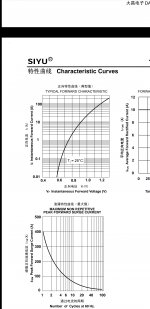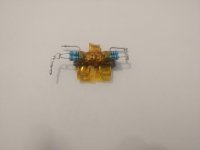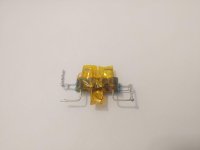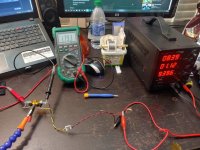I am trying to simulate an M140 diode, and I would like to run it at exactly 1.8A.
(The driver I'm using can supply up to 5A, so I fear the possibility of accidentally over-currenting my diode.)
For Test/Dummy Load:
NOW HERE'S MY ACTUAL QUESTION/PROBLEM:
SO... I am slightly conflicted on how many diodes to put in series.
It seems like I should only use 4 diodes in series. Yay or Nay?
Thank you for your input.
(The driver I'm using can supply up to 5A, so I fear the possibility of accidentally over-currenting my diode.)
For Test/Dummy Load:
Rectifiers: I will be using 10A10, because I have a ton of them already. (I have plenty of 1n4007 too, however unsuitable at this current.)
Forward voltage drop @ 1.8A = 0.8V (according to datasheet figure)
Current-Sense Resistor: I will use a 2x2 Series-Parallel arrangement of 4x 1 Ohm, 1W metal-film resistors, which will have an equivalent resistance of 1 Ohm. (Using 1W because it's just what I have on-hand already.) This new resistor is rated for 4W, but will be dissipating 3.24W @ 1.8A.
NOW HERE'S MY ACTUAL QUESTION/PROBLEM:
I have looked at various threads regarding this already, and have concluded that the voltage drop for the M140 diode is "somewhere around 4.5V"...
Looked at several threads on test loads, and I have seen that diagram that everybody here uses as a reference.
However, I'm still not sure how many diodes to use, so I did some calculations for test loads between 4 to 6 diodes.
If I use 4 diodes in series, @ 1.8A, they total up to 3.2V drop.
If I use 5 diodes in series, @ 1.8A, they total up to 4.0V drop.
If I use 6 diodes in series, @ 1.8A, they total up to 4.8V drop.
When I add in the 1.8V drop from the 1 Ohm resistor, I get:
The 4 diode test load @ 1.8A will have a total voltage-drop of 5.0V.
The 5 diode test load @ 1.8A will have a total voltage-drop of 5.8V.
The 6 diode test load @ 1.8A will have a total voltage-drop of 6.6V.
SO... I am slightly conflicted on how many diodes to put in series.
It seems like I should only use 4 diodes in series. Yay or Nay?
Thank you for your input.













